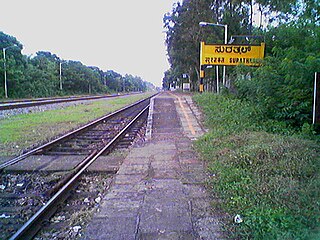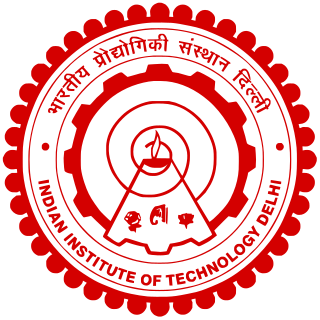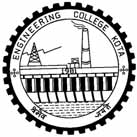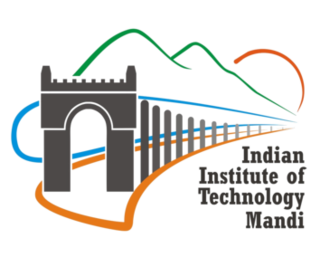
Indian Institute of Technology, Roorkee is a technical university located in Roorkee, Uttarakhand, India. It is the oldest engineering institution in India. It was founded as the College of Civil Engineering in 1847 during East India Company rule in India by James Thomason, the Lieutenant-Governor of the North-Western Provinces in which Roorkee was located; its purpose was to train officers and surveyors employed in the construction of the Ganges Canal. In 1854, after the completion of the canal and Thomason's death, it was renamed the Thomason College of Civil Engineering by Proby Cautley, the designer and projector of the canal. It was renamed University of Roorkee in 1949, and again renamed IIT Roorkee in 2001. The institution has 22 academic departments covering Engineering, Applied Sciences, Humanities & Social Sciences and Management programs with an emphasis on scientific and technological education and research.
The National Institutes of Technology (NITs) are centrally funded technical institutes under the ownership of the Ministry of Education, Government of India. They are governed by the National Institutes of Technology, Science Education, and Research Act, 2007, which declared them institutions of national importance and laid down their powers, duties, and framework for governance. The act lists 32 NITs. Each NIT is autonomous and linked to the others through a common council known as the Council of NITSER, which oversees their administration. All NITs are funded by the Government of India.

National Institute of Technology Calicut, formerly Regional Engineering College Calicut, is a public technical university and an institute of national importance governed by the NIT Act passed by the Parliament of India. The campus is situated 22 kilometres (14 mi) northeast of Kozhikode, on the Kozhikode–Mukkam Road. It was established in 1961 and was known as Calicut Regional Engineering College (CREC) until 2002. It is one of the National Institutes of Technology campuses established by the Government of India to impart high standard technical education to students from all over the country. NIT Calicut hosts a supercomputer on its campus, and has a dedicated nanotechnology department.

University of Visvesvaraya College of Engineering (UVCE) was established in 1917, under the name Government Engineering College, by Bharat Ratna Sir M. Visvesvaraya. It is the 5th engineering college to be established in the country and 1st in Karnataka. UVCE is one of the few technical institutions in the country that is vested with the status of a university and autonomy on the lines of IITs. It is one of the oldest technical institutions in the country, imparting technical education leading to B.Tech., B. Arch., M.Tech., M. Arch. and PhD degrees in the various disciplines of Engineering and Architecture. The college is approved by the AICTE and the Government of Karnataka. UVCE has secured an NAAC accreditation score of 3.75. UVCE, while a constituent college of Bangalore University until 2022, secured an NIRF ranking of 64. The college used to receive financial aid under the TEQIP program from the World Bank.

Model Engineering College or MEC is a government cost-sharing technical institute and research centre in Thrikkakara, Kochi, Kerala, India. It was established by the Institute of Human Resources Development (IHRD), an autonomous agency under the Government of Kerala, in 1989. It is affiliated to the APJ Abdul Kalam Technological University (KTU) since 2015.

Rashtreeya Vidyalaya College of Engineering is an autonomous private engineering college in Bangalore, Karnataka, India. It was established in 1963 under the Rashtreeya Sikshana Samithi Trust (RSST) and was one of the earliest self-financing engineering colleges in the country. It is affiliated with the Visvesvaraya Technological University, Belgaum. In 2008, the college was given autonomous status.

Dr. B. R. Ambedkar National Institute of Technology Jalandhar, formerly Regional Engineering College Jalandhar, is a public engineering university located in Jalandhar, Punjab, India established on 1987. It has been declared as an Institute of National Importance under the Ministry of Human Resource Development, Govt of India. It is a member of the National Institutes of Technology (NITs) system, a group of premier Indian technical institutes governed by the Council of NITSER on 2002. It was founded as a joint venture between the state and the central government, originally under the name Regional Engineering College, Jalandhar, Punjab, India (RECJ). RECJ was established in 1989 by the joint venture of Govt of India and Govt of Punjab on the Land of Village Bidhipur and Village Suranussi of District Jalandhar (Punjab) on the Grand Trunk Road bye-pass.

Visvesvaraya Technological University (VTU), is a collegiate public state university in Belagavi, Karnataka established by the Government of Karnataka. It is one of the largest Technological Universities in India with 26 years of Tradition of excellence in Engineering & Technical Education, Research and Innovations. It came into existence in the year 1998 to cater the needs of Indian industries for trained technical manpower with practical experience and sound theoretical knowledge. The university is named after Sir M. Visvesvaraya, an Indian civil engineer, statesman and the 19th Diwan of Mysore.

Sardar Vallabhbhai National Institute of Technology, Surat or National Institute of Technology, Surat, is a public technical university established by the Parliament of India in 1961. It is one of 31 National Institutes of Technology in India recognized by the Government of India as an Institute of National Importance. It is the Anchor Institute for the Auto and Engineering sector and will be training the workforce. The project is also designated as the "Center of Excellence under Technical Education Quality Improvement Program" in water resources and flood management and is supported by the World Bank.
Punjab Engineering College (Deemed to be University) (abbreviated PEC or PEC Chandigarh) is a public research & technical institution in Chandigarh. It was founded in 1921 in Lahore, established in Chandigarh in 1953, and focuses on the field of applied sciences, particularly engineering and technology. It is well-known for its undergraduate and graduate programmes in engineering, to which the entry is through the Joint Entrance Examination – Mains and Graduate Aptitude Test in Engineering. It offers degrees such as Bachelor of Technology, Master of Technology and MBA. It also has a comprehensive graduate program offering doctoral degrees in Science, Technology, Engineering and Mathematics.

Surathkal is one of the major localities in the northern part of Mangalore taluk located on National Highway 66 in the Dakshina Kannada district, Karnataka state, India on the shore of Arabian sea. It is a municipality merged with Mangalore City Corporation. It lies between Gurupura (Phalguni) and Pavanje (Nandini) rivers. It is the northern suburb and can be considered as the northernmost area of Mangalore City until Mukka. Surathkal has a railway station on Konkan railway route which connects cities of Mumbai to Mangaluru. Surathkal is 8 km north of New Mangalore seaport, 4 km west of Mangalore Refinery and Petrochemicals Limited and 16 km west of Mangalore International Airport This region has developed educationally, industrially and commercially can be regarded as one of the crucial localities in Mangaluru and coastal Karnataka. The only NIT of Karnataka is situated here which is adjacent to the national highway NH 66. Mukka a popular name in Indian surfing is also situated close to Surathkal. Surathkal beach is well known for its cleanliness and well maintained like other beaches in Mangalore.

Manipal Institute of Technology is a private engineering college under Manipal Academy of Higher Education in India.
Incident is the annual cultural festival of the National Institute of Technology Karnataka (NITK) in Surathkal, Karnataka, India. The fest is a four-day-long event held in March in the even semester of the NITK Calendar. The fest brings together students from different colleges all over India, attracting an estimated annual footfall of about 45,000 people, and boasts a number of competitive events, workshops, competitions and performances as well as pro-shows by widely known and popular artists including the likes of Sunidhi Chauhan, Salim–Sulaiman, Amaal Malik, Benny Dayal, the duo of Vishal–Shekhar and Javed Ali among many others.

The Indian Institute of Technology Delhi(IIT- Delhi) is a public institute of technology located in Delhi, India. It is one of the 23 Indian Institutes of Technology created to be a Centre of Excellence for India's training, research and development in science, engineering and technology.

The Engineering College Kota is an autonomous technical institute in Northern India. It houses the headquarters of Rajasthan Technical University and, hence, is referred as University Department of Rajasthan Technical University (UD-RTU). The institute was established in 1981 by the Government of Rajasthan and was named Engineering College, Kota.

Indian Institute of Technology Ropar is a public technical university located in Rupnagar, Punjab, India. It is one of the eight Indian Institutes of Technology (IITs) established in 2008 by the Ministry of Human Resource Development (MHRD), Government of India under The Institutes of Technology (Amendment) Act, 2011 to expand the reach and enhance the quality of technical education in the country.

Indian Institute of Technology Mandi is a public technical university located in Kamand Valley, Mandi district of Himachal Pradesh, India. It is one of eight new Indian Institutes of Technology (IITs) established by the Ministry of Human Resource Development, Government of India, and recognized as one of Institutes of National Importance.

National Institute of Technology Goa is an engineering institution in the Indian state of Goa. It was founded in 2010 being one of the 31 National Institutes of Technology in India and is recognised as an Institute of National Importance. It admitted its first batch of students in 2010-11.

India has the largest numbers of engineers as well as the largest number of engineering education institutes and infrastructure in the world. As of 2021, India annually produces one million engineering graduates. India's technical education infrastructure includes 3500 engineering colleges, 3400 polytechnics and 200 schools of planning and architecture.

NITK Beach also known as Surathkal beach is on the Arabian Sea coast at Surathkal, 16 km (9.9 mi) north of the centre of Mangalore city, in the Dakshina Kannada district of Karnataka, India. It is a private beach that was later named after the nearby NITK.

























